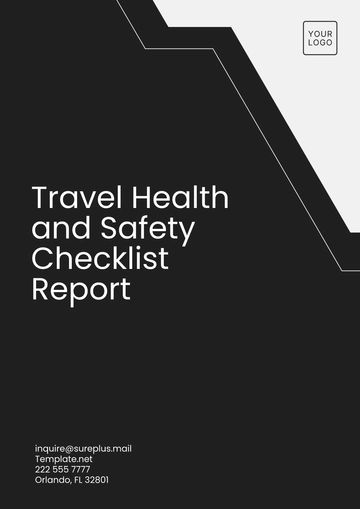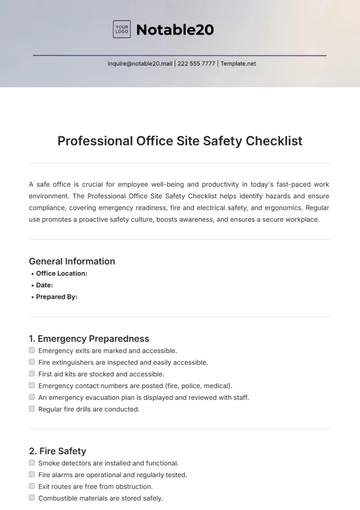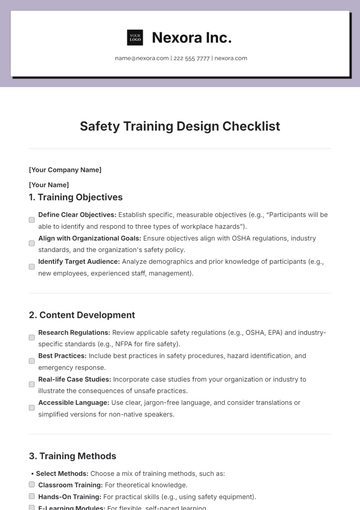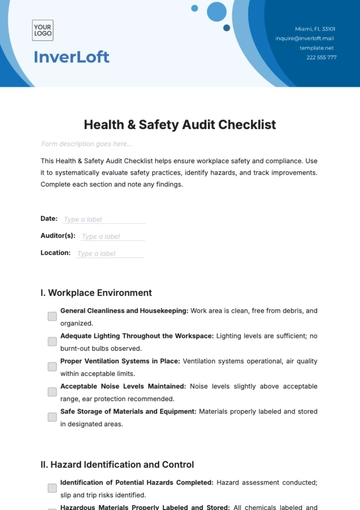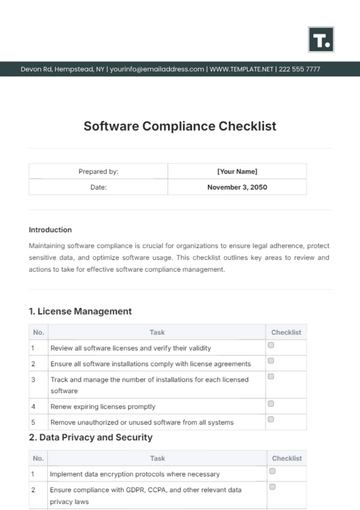Free Travel Health and Safety Checklist Report

Prepared by: [Your Name]
Date: January 1, 2060
1. Introduction
Traveling can be an enjoyable and enriching experience, offering exposure to new cultures, landscapes, and people. However, it also requires thoughtful preparation to ensure the health and safety of travelers. This report outlines a comprehensive checklist to help travelers prepare for their journeys and address potential health and safety concerns. Proper planning can minimize risks and make the travel experience more enjoyable.
2. Pre-Trip Preparations
2.1. Research and Information Gathering
Before embarking on a trip, gathering essential information about the destination is crucial to ensure a smooth journey. Here are some key considerations:
Travel Advisories and Safety Alerts: Always check for updated travel advisories from government agencies or international organizations like the World Health Organization (WHO) or Centers for Disease Control and Prevention (CDC).
Local Laws and Regulations: Research local laws, especially those related to health, safety, and cultural norms. Understanding the rules of your destination will help avoid misunderstandings.
Climate and Environmental Conditions: Know the typical weather patterns during your travel dates. Be prepared for extreme heat, cold, or seasonal weather events (e.g., monsoons, snowstorms).
Local Health Services: Familiarize yourself with nearby hospitals, clinics, pharmacies, and emergency contacts. Know how to reach them in case of a medical emergency.
2.2. Health Preparations
Preventing health issues while traveling is a priority. Consider the following steps:
Consult with Healthcare Providers: Schedule a visit with a healthcare provider before traveling, especially if your destination has specific health risks. Discuss required vaccines and necessary medications.
Vaccinations: Ensure that all routine vaccinations (e.g., flu, tetanus) are up-to-date. Some destinations may require specific vaccines, such as yellow fever, before entry.
Prescription Medications: Carry enough prescription medications for the duration of the trip. Bring along copies of your prescriptions, in case you need a refill.
Travel Health Kit: Pack a travel health kit with essential first-aid supplies, such as pain relievers, antiseptics, bandages, insect repellent, and any over-the-counter medicines you might need.
3. Travel Safety Measures
3.1. Transportation Safety
Transportation is one of the most critical aspects of travel. Travelers should take the following precautions:
Choose Reputable Airlines: When booking flights, select airlines with good safety records. Consider looking up safety rankings and reviews.
Safe Ground Transportation: Use licensed taxis or reputable ride-sharing apps with safety features such as driver identification and GPS tracking.
Driving Safety: If renting a car, familiarize yourself with local driving laws, road conditions, and traffic rules. Always wear seatbelts, regardless of the country’s laws.
Public Transport: When using public transportation, remain alert. Avoid displaying valuables or using your phone in crowded areas.
3.2. Accommodation Safety
Ensuring safety while staying at your accommodation is crucial. Follow these steps to safeguard your well-being:
Research Accommodation Options: Read online reviews from reliable sources like TripAdvisor or Booking.com to assess safety and security at potential hotels or hostels.
Emergency Preparedness: Upon check-in, locate emergency exits and familiarize yourself with the fire safety and evacuation plans. Ensure that your room has functioning smoke detectors.
Valuables: Store valuable items like passports, electronics, and jewelry in a secure hotel safe or lockbox.
Room Security: Always lock your door and close windows securely when leaving or sleeping. Use additional security measures, such as chain locks or door wedges.
4. Destination-Specific Considerations
4.1. Health-Related Risks by Region
Each region has its own set of health risks, and travelers should be aware of common issues in specific destinations:
Asia: Traveler's diarrhea, mosquito-borne diseases (e.g., malaria, dengue), and respiratory infections.
Africa: Yellow fever, malaria, cholera, and African trypanosomiasis (sleeping sickness).
South America: Zika virus, dengue fever, and altitude sickness (especially in the Andean regions).
Oceania: Tropical diseases like dengue fever, malaria in some areas, and the risk of sunburn due to high UV levels.
4.2. Safety Risks by Region
In addition to health risks, there are unique safety concerns based on location:
High-Crime Areas: Research the safety of neighborhoods or regions you plan to visit. Avoid areas with high crime rates and consult local advisories for guidance.
Natural Disasters: Familiarize yourself with risks such as earthquakes, hurricanes, or floods, especially in regions prone to these events.
Political Instability: Be aware of any political unrest or protests that may disrupt travel plans. Keep updated on local news.
5. On-Trip Practices
5.1. Health Maintenance
Maintaining good health during travel requires continuous care and awareness:
Stay Hydrated: Drink plenty of bottled or filtered water, especially in areas with limited access to clean water.
Dietary Precautions: Avoid street food or food from unknown sources that may cause foodborne illnesses. Stick to well-cooked meals and drink bottled beverages.
Insect Protection: Apply insect repellent regularly to protect against mosquito-borne diseases, such as malaria or dengue.
Hand Hygiene: Use hand sanitizer frequently, especially before meals, and avoid touching your face in public spaces.
5.2. Personal Safety Practices
Keeping yourself safe during travel requires vigilance:
Avoid Drawing Attention: Avoid wearing flashy jewelry or displaying wealth, as this can attract unwanted attention in some areas.
Situational Awareness: Stay aware of your surroundings, particularly in busy areas like markets, public transport, and tourist attractions.
Secure Important Documents: Carry a copy of your passport and travel documents in a secure location, separate from the originals. Use a money belt or hidden pouch for valuables.
Stay Connected: Inform a trusted friend or family member about your travel plans and regularly check in with them. Share your itinerary, accommodation details, and contact information.
6. Emergency Preparedness
While every effort can be made to prevent incidents, emergencies can happen. Be prepared:
Emergency Contacts: Know how to contact local emergency services. Save the numbers for police, fire, medical services, and your country's embassy or consulate.
Travel Insurance: Consider purchasing comprehensive travel insurance that covers health emergencies, trip cancellations, lost baggage, and other unforeseen situations.
Know Basic First Aid: Familiarize yourself with basic first-aid procedures, such as CPR and wound care, in case of an emergency. Carry an emergency contact card with relevant medical information.
7. Conclusion
Travel health and safety require thorough preparation, informed decision-making, and proactive measures throughout the trip. By following this checklist, travelers can mitigate potential risks and focus on enjoying the journey. Prioritize health and safety to ensure that your travel experience is not only memorable but also safe and secure.
- 100% Customizable, free editor
- Access 1 Million+ Templates, photo’s & graphics
- Download or share as a template
- Click and replace photos, graphics, text, backgrounds
- Resize, crop, AI write & more
- Access advanced editor
Stay prepared with the Travel Health and Safety Checklist Report Template from Template.net. This customizable, professional-grade template ensures comprehensive travel safety planning. Fully editable and tailored to your needs, it’s editable in our AI Editor Tool for seamless personalization. Simplify your travel planning with this essential tool, designed for convenience and reliability.
You may also like
- Cleaning Checklist
- Daily Checklist
- Travel Checklist
- Self Care Checklist
- Risk Assessment Checklist
- Onboarding Checklist
- Quality Checklist
- Compliance Checklist
- Audit Checklist
- Registry Checklist
- HR Checklist
- Restaurant Checklist
- Checklist Layout
- Creative Checklist
- Sales Checklist
- Construction Checklist
- Task Checklist
- Professional Checklist
- Hotel Checklist
- Employee Checklist
- Moving Checklist
- Marketing Checklist
- Accounting Checklist
- Camping Checklist
- Packing Checklist
- Real Estate Checklist
- Cleaning Checklist Service
- New Employee Checklist
- Food Checklist
- Home Inspection Checklist
- Advertising Checklist
- Event Checklist
- SEO Checklist
- Assessment Checklist
- Inspection Checklist
- Baby Registry Checklist
- Induction Checklist
- Employee Training Checklist
- Medical Checklist
- Safety Checklist
- Site Checklist
- Job Checklist
- Service Checklist
- Nanny Checklist
- Building Checklist
- Work Checklist
- Office Checklist
- Training Checklist
- Website Checklist
- IT and Software Checklist
- Performance Checklist
- Project Checklist
- Startup Checklist
- Education Checklist
- Home Checklist
- School Checklist
- Maintenance Checklist
- Planning Checklist
- Manager Checklist
- Wedding Checklist
- Vehicle Checklist
- Travel Agency Checklist
- Vehicle Inspection Checklist
- Interior Design Checklist
- Backpacking Checklist
- Business Checklist
- Legal Checklist
- Nursing Home Checklist
- Weekly Checklist
- Recruitment Checklist
- Salon Checklist
- Baby Checklist
- Equipment Checklist
- Trade Show Checklist
- Party Checklist
- Hospital Bag Checklist
- Evaluation Checklist
- Agency Checklist
- First Apartment Checklist
- Hiring Checklist
- Opening Checklist
- Small Business Checklist
- Rental Checklist
- College Dorm Checklist
- New Puppy Checklist
- University Checklist
- Building Maintenance Checklist
- Work From Home Checklist
- Student Checklist
- Application Checklist




